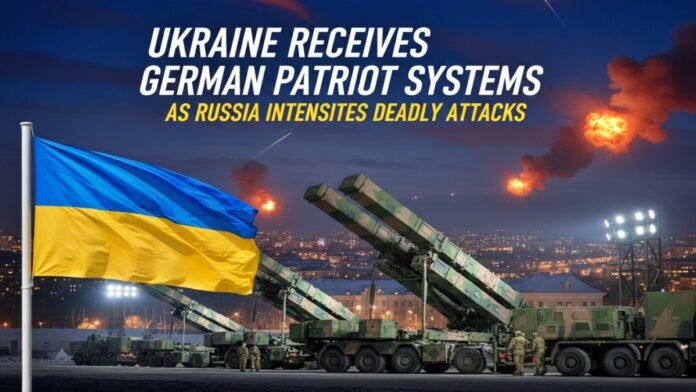
Key Points:
- Ukraine confirmed receipt of additional Patriot air defense systems from Germany on November 1, 2025, fulfilling promises made three months prior by Defense Minister Boris Pistorius
- Russia launched devastating overnight strikes on November 1-2, 2025, firing 12 missiles and 138 attack drones across Ukraine, killing at least 15 people including two children
- Power outages affected nearly 60,000 residents in Zaporizhia region following the attacks; Russian energy infrastructure bombing campaign targeting winter months intensified
- President Zelensky stated that strengthened Patriot defenses are critical to ending Russian terror and civilian casualties; production capacity remains limited globally with components taking years to manufacture
- Germany supplied Ukraine with three previous Patriot systems; latest delivery includes two additional batteries under U.S. manufacturer replenishment agreement with NATO/EU backing
- Ukraine’s domestically-produced long-range drones struck Tuapse Black Sea oil port and Saratov oil refinery in retaliation, causing fires and damaging foreign vessels
- Trump administration launched PURL (Priority Ukraine Requirements List) program in July 2025 with $10 billion capacity, enabling NATO allies to purchase U.S. weapons for Ukraine without direct U.S. aid restrictions
- President Trump stated in November 2025 he is not contemplating arrangements allowing Ukraine to acquire long-range Tomahawk missiles for strikes on Russian territory
- Patriot system consists of radar units, fire control centers, multiple launchers (4-8 per battery), and support equipment; each battery can intercept ballistic missiles, cruise missiles, and aircraft
- Trump approved $1 billion first weapons package under PURL mechanism in September 2025, with total aid package discussions reportedly worth approximately ₹90 billion
Kyiv: Ukraine has bolstered its critical air defense capabilities following Germany’s delivery of additional Patriot air defense systems, marking a significant reinforcement of Kyiv’s defenses against Russia’s relentless aerial bombardment campaign. President Volodymyr Zelensky announced the delivery on November 1, 2025, expressing gratitude to German Chancellor Friedrich Merz and emphasizing the strategic importance of these systems in protecting civilians and infrastructure.
Germany Fulfills Patriot Promise
The delivery fulfills Germany’s commitment made approximately three months earlier, when Defense Minister Boris Pistorius announced that Berlin would provide Ukraine with two additional Patriot systems by the end of 2025. According to Zelensky’s statement, this was not merely a supply of equipment but represented months of careful preparation and diplomatic coordination. “For some time, we have been preparing this reinforcement of our air defense, and now the agreements reached have been implemented,” Zelensky wrote on social media. He added, “We have strengthened the ‘Patriot’ component of our Ukrainian air defense”.
Strategic Importance Under Intensified Russian Assault
The timing of the Patriot delivery is particularly significant given Russia’s escalating aerial offensive. Since spring 2025, Russian aerial attacks against Ukraine have dramatically increased in scope and intensity, with the Kremlin prioritizing a systematic campaign to destroy Ukraine’s energy infrastructure ahead of the brutal winter months. Zelensky characterized these attacks as Putin’s primary strategic tool, stating: “Russian air strikes are Putin’s main stake in this war through terror he tries to compensate for his inability to achieve his insane goals on the ground”.
Germany’s Patriot Arsenal History
Before this latest delivery, Germany had supplied Ukraine with three Patriot systems, making it one of the largest contributors of advanced air defense equipment to Kyiv. The additional batteries are being supplied under a special replenishment agreement with the U.S. manufacturer, in which Germany commits to restocking U.S. Patriot systems for its own military while simultaneously strengthening Ukraine’s air defenses. This arrangement reflects the complex logistical and diplomatic coordination required to route sophisticated military technology to Ukraine amid global supply constraints.
Catastrophic Overnight Missile and Drone Barrage
Despite receiving additional air defense systems, Ukraine endured one of the most devastating attacks in recent weeks during the night of November 1-2, 2025. Russian forces launched a comprehensive aerial assault comprising 12 missiles and 138 attack drones against multiple targets across Ukraine. According to the Kyiv Independent, this barrage killed at least 15 people, including two minors.
Widespread Power Outages in Zaporizhia
The attacks caused catastrophic damage to Ukraine’s already-battered energy infrastructure, with Ukrainian officials reporting that power outages affected nearly 60,000 residents in the southern frontline area of Zaporizhia. This particular region, which has become a major battleground as Russian forces broke through in late August 2025, has experienced repeated Russian attacks on civilian infrastructure. The power disruptions occurred as winter approaches, threatening to leave hundreds of thousands of Ukrainians without heating, water pumping, or essential services during the cold months.
Sumy Region Residential Strike
A particularly brutal incident occurred in the northeastern Sumy region, where Russian drone operators targeted a residential house with the apparent intent to kill civilians during their sleep. The attack killed one person and injured five family members, including two children, according to regional head Oleh Grigorov. Grigorov explicitly stated that Russia deliberately timed the strike for nighttime hours when residents would be in their homes, indicating a deliberate targeting of civilians rather than military installations.
Ukrainian Civilian Casualties Mount
The November 1-2 barrage added to an already catastrophic toll on Ukrainian civilians. In Dnipropetrovsk Oblast, four civilians were killed on November 1, including an 11-year-old and a 14-year-old, with six others wounded in Russian airstrikes. This pattern of attacks targeting populated areas, particularly at night when civilians are sheltering in homes, has become a consistent feature of Russia’s aerial campaign.
Ukraine Launches Retaliatory Strikes
In response to Russian aggression, Ukraine has intensified its own long-range drone operations, targeting Russian energy infrastructure and military assets deep within Russian territory. Ukrainian drone strikes successfully struck the Tuapse oil port, one of Russia’s principal Black Sea oil ports, on November 1, igniting a fire and damaging at least two foreign-flagged vessels docked at the facility. According to port authorities in Russia’s Krasnodar region, the attack caused significant damage to oil tanker vessels and port infrastructure.
Saratov Oil Refinery Targeted
Ukrainian forces followed up with drone strikes on the Saratov Oil Refinery in southern Russia’s Saratov region overnight on November 2-3. This represented at least the fourth drone attack on the Saratov region since Russia’s February 2022 invasion of Ukraine. Ukrainian military analysts note that these retaliatory strikes serve dual purposes: degrading Russia’s economic capacity to sustain military operations while bypassing Western restrictions on long-range weapons by relying on domestically-produced drone technology.
Ukraine’s Homegrown Drone Advantage
A significant development in Ukraine’s military strategy has been its increasing reliance on domestically-produced long-range drones, which can be deployed without the approval requirements tied to Western-supplied weapons. According to reporting from Euronews, these drones are “built in the shadows” and “launched at night,” constructed from parts made in scattered networks of underground workshops across Ukraine. This capability allows Ukraine to maintain strike capacity against Russian targets without waiting for political approval from Western allies regarding the use of imported systems.
Russian Airport Closures
Following Ukraine’s retaliatory strikes, Russia temporarily suspended numerous airports, particularly those in the southern and western regions of the country, as a precautionary measure against potential additional drone attacks. Russia’s aviation regulator Rosaviatsiya announced the closures via Telegram, demonstrating the level of concern Russian authorities have about Ukraine’s expanding drone capabilities.
Patriot System Capabilities and Limitations
The U.S.-made Patriot air defense system represents one of the world’s most advanced anti-missile technologies currently available. A typical Patriot battery consists of radar units for target detection and tracking, a fire control center, missile launchers, and comprehensive support equipment, including power supplies and communications systems. Depending on configuration, each battery includes between four and eight launchers capable of firing multiple types of missiles designed to intercept ballistic missiles, cruise missiles, and aircraft.
Global Supply Constraints
Despite the critical importance of Patriot systems to Ukraine’s defense, supplies remain extremely limited globally. Manufacturing advanced radar systems, fire control computers, and missile components requires years of production time, with specialized semiconductor fabrication and precision engineering creating significant bottlenecks. This constraint means that every Patriot system provided to Ukraine comes at the expense of NATO allies’ own strategic reserves, explaining the diplomatic complexity surrounding their provision.
PURL Program: New U.S. Strategy
In a significant policy shift, President Donald Trump announced in July 2025 the creation of the PURL (Priority Ukraine Requirements List) program, a NATO and EU-backed initiative designed to circumvent traditional bilateral aid channels. Under PURL, NATO allies purchase U.S.-made weapons systems directly from American manufacturers, with the weapons subsequently provided to Ukraine. This mechanism allows the Trump administration to claim that U.S. military aid is not directly supporting Ukraine while simultaneously enabling substantial weapons transfers through allied nations.
$1 Billion First PURL Package
In September 2025, the Trump administration approved the delivery of the first two packages of weapons under the PURL mechanism, totaling approximately $1 billion from U.S. military stockpiles. These weapons would be funded by NATO allies rather than U.S. taxpayers, representing a novel approach to supporting Ukraine’s defense while managing the Trump administration’s domestic political considerations. The PURL mechanism has a total capacity of up to $10 billion in weapons transfers.
Patriot Intercept Success Rate
Ukrainian officials have reported that Patriot systems have been instrumental in destroying Russian missiles and drones, though complete interception of all incoming threats remains impossible. During the November 1-2 barrage of 12 missiles and 138 drones, Patriot systems and other air defense equipment destroyed many attackers, though some missiles penetrated defenses and caused damage. The sheer volume of Russian attacks, firing 150 projectiles in a single night, overwhelms any purely defensive system, highlighting Ukraine’s continued vulnerability despite strengthened air defenses.
Russia’s Energy Destruction Campaign
Russian military strategy in late 2025 has prioritized systematic destruction of Ukraine’s energy infrastructure, particularly power plants and heating systems. This approach, described by analysts as economic warfare, aims to break Ukrainian civilian morale and reduce the country’s capacity to sustain its war effort. By targeting energy infrastructure before winter, Russia hopes to create mass civilian suffering that might pressure Kyiv into accepting unfavorable peace terms.
Western Support Coordination
NATO and EU nations have coordinated closely to provide Ukraine with critical air defense systems while managing the Trump administration’s constraints on weapons supplies. The PURL mechanism represents a creative institutional workaround to maintain Western support for Ukraine’s defense despite political divisions within the alliance. However, this ad-hoc approach also reveals the fragility of Western support, as any change in U.S. policy direction could dramatically alter the availability of weapons systems.
Scale of Displacement and Casualties
Since Russia’s February 2022 invasion, thousands of Ukrainians have been killed and millions displaced, creating one of Europe’s worst humanitarian crises in recent decades. The ongoing aerial bombardment campaign ensures that civilian casualties continue to mount, with every Russian missile or drone attack risking additional deaths among non-combatants.
Future Outlook for Ukraine’s Air Defense
As winter 2025 approaches, Ukraine faces an intensifying Russian aerial offensive while attempting to rebuild and reinforce its air defense capabilities with limited global supplies. The delivery of additional Patriot systems provides temporary relief but cannot fully address Ukraine’s defensive needs. Zelensky has indicated that ongoing negotiations are underway for “further results” regarding Ukraine’s air defenses, suggesting that additional international military cooperation agreements may soon be announced.
The convergence of Germany’s Patriot delivery, Russia’s intensified attacks, and the Trump administration’s ambivalent approach to Ukraine’s military needs creates a complex geopolitical moment where Ukraine’s survival increasingly depends on sustained international support amid shifting political priorities.






















































